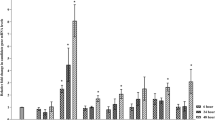Abstract
The production of trichothecene toxins is a suspected virulence mechanism of several plant pathogenic fungi. This hypothesis has been confirmed forGibberella zeae (Fusarium graminearum) by gene disruption experiments, suggesting in turn, that resistance against the fungal toxin is a relevant component ofFusarium resistance of the host plant. Our goal is therefore to identify molecular mechanisms of trichothecene resistance. Using yeast as a model system we have found the following resistance mechanisms and genes: a) reduced uptake of deoxynivalenol (PDR5), b) toxin modification and reduction of toxicity (AYT1), and c) formation of a resistant toxin target (RPL3). Homologous plant genes exist and are attractive candidates forFusarium resistance genes.
Similar content being viewed by others
References
Balzi E, Goffeau A (1995) Yeast multidrug resistance: the PDR network. J. Bioenerg. Biomembr. 27: 71–76.
Cundliffe E, Davies, JE (1977) Inhibition of initiation, elongation and termination of eukaryotic protein synthesis by trichothecene fungal toxins. Antimicrob. Agents Chemother. 11: 491–499.
Decottignies A, Goffeau A (1997) Complete inventory of the yeast ABC proteins. Nat. Genet. 15: 137–145.
Desjardins AE, Proctor RH, Bai G, McCormic SP, Shaner G, Buechely G, Hohn TM (1996) Reduced virulence of trichothecene antibiotic-nonproducing mutants of Gibberella zeae in wheat field tests. Mol. Plant Microbe Interact. 9: 775–781.
Fried HM, Warner JR (1981) Cloning of a yeast gene for trichodermin resistance and ribosomal protein L3. Proc. Natl. Acad. Sci. USA 78: 238–242.
Grove JF (1988) Non-macrocyclic trichothecenes. Nat. Prod. Rep. 5: 187–209.
Grove JF (1993) Macrocyclic trichothecenes. Nat. Prod. Rep. 10: 429–454.
Grove JF (1996) Non-macrocyclic trichothecenes, part 2. In: Prog. Chem. Org. Nat. Prod. 69: 1–70. (Herz W, Kirby G, Moore R, Steglich W, Tamm C, eds.), Springer Verlag, Wien.
Güldner U, Heck S, Fiedler T, Beinhauer J, Hegemann JH (1996) A new efficient gene disruption cassette for repeated use in budding yeast. Nucl. Acids Res. 24: 2519–2524.
Guthrie C, Fink GR (1991) Guide to yeast genetics and molecular biology. Methods Enzymol. 194.
Kimura M, Kaneko I, Komiyama M, Takatsuki A, Koshino H, Yoneyama K, Yamaguchi I (1998) Trichothecene 3-O-acetyltransferase protects both the producing organism and transformed yeast from related mycotoxins. J. Biol. Chem. 273: 1654–1661.
Mesterházy A. (1995) Types and components of resistance to Fusarium head blight of wheat. Plant Breeding 114: 377–386.
Miller JD, Ewen MA (1998): Toxic effects of deoxynivalenol on ribosomes and tissues of the spring wheat cultivars Frontana and Casavant. Nat. Tox. 5: 234–237.
Proctor RH, Hohn TM, McCormic SP (1995) Reduced virulence of Gibberella zea caused by disruption of a trichothecene toxin biosynthetic gene. Mol. Plant-Microbe Interact. 8: 593–604.
Schuster M, Lepschy J, Biber A, Engelhard G, Wallnöfer PR (1987) Production of mycotoxins by Fusarium species isolated in Germany. Z. Lebensm. Unters. Forsch. 185: 477–480.
Sikorsky RS, Hieter P (1989) A system of shuttle vectors and yeast host strains designed for efficient manipulation of DNA in Saccharomyces cerevisiae. Genetics 122: 19–27.
Author information
Authors and Affiliations
Rights and permissions
About this article
Cite this article
Adam, G., Mitterbauer, R., Raditschnig, A. et al. Molecular mechanisms of deoxynivalenol resistance in the yeastSaccharomyces cerevisiae . Mycotox Res 17 (Suppl 1), 19–23 (2001). https://doi.org/10.1007/BF03036704
Published:
Issue Date:
DOI: https://doi.org/10.1007/BF03036704




